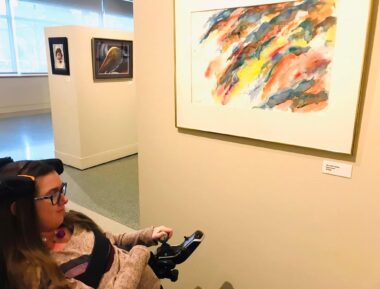Do children hold the key to improved accessibility?

Growing up, I loved the library’s summer reading program. I’ve always been a bookworm, so logging hours of reading and being rewarded for my hobby was a highly satisfying endeavor. My favorite prizes were, of course, new books.
Last year, I was thrilled to learn that this program from my childhood had been expanded to include adults, and a winter edition had also been added. Both programs have an app where I can easily track my progress and enter the tickets I win into various raffles.
Although the app grants me access to all of the reading program’s features, my participation over the winter prompted my mom and I to take a trip to the library to make sure I was correctly collecting my prizes. Plus, we have a beautiful, expansive library downtown that you don’t need a reason to visit. While we were there, I had an interesting revelation about accessibility.

Halsey Blocher admires a painting in the art gallery at her local library on Jan. 20. (Courtesy of Halsey Blocher)
An interesting discovery
As I rolled through the hallways inquiring about the reading program, I found myself having conversations with people I couldn’t fully see. As is the case in many public locations, the desks and countertops were built at a height that accommodates people who are standing.
I could have eliminated the height difference by using my wheelchair’s elevation feature, which lifts my seat to a standing eye level. It’s designed to allow people with SMA and other disabilities to reach high surfaces, see over a crowd, have face-to-face conversations, and safely transfer to and from the chair, all so we can be more active, equal members of our communities. But for these brief interactions, I left my wheelchair in the lowered position, knowing that the conversations were likely to end before I reached my full height.
We were soon directed to the children’s department. Although I was enrolled in the adult reading level, the children’s librarians were still the experts. This is where I made a pleasant discovery: Built for the shorter stature of children, the desk in this space was just my height! Here, I could maintain eye contact and converse without changing my position or asking someone to bend over.
More accessibility ideas
For months, my mind circled back to that moment and the realization that things made for children are often accessible to people with disabilities. And this idea doesn’t just apply to big things like furniture and architecture. It’s also true of little, everyday things like lightweight silverware, easy-to-open containers, or Velcro shoes.

A fun kids’ cup is the perfect way for Halsey Blocher to drink her strawberry smoothie at a restaurant in North Carolina in July 2023. (Courtesy of Halsey Blocher)
Restaurant cups provide another example. Whenever possible, I order drinks in to-go cups because I’m unlikely to drink more than half before the meal is over. Swallowing usually requires too much strength and energy to finish an entire glass in one sitting, so I take the rest home and put it in the fridge to finish later.
I pretty much know what to expect when I ask for a to-go cup, but while vacationing with my family this past summer, I was surprised by how one restaurant met my request. They brought my drink out in a kids’ cup! I realize that to some this may seem like an insult, but it was actually a perfect solution for me. It had a secure lid with a straw, and the smaller container was easier to drink from without tilting it at awkward angles.
Learning from children
To be clear, I’m in no way suggesting that disabled adults should be infantilized or viewed as childlike. According to an article from Psychology Today, “Infantilization is often a form of ableism. Some people use condescending and patronizing language when talking to people with disabilities. They may raise their voices and speak slowly and deliberately, or ignore the person altogether by talking to their companion, sign language interpreter, or another adult instead.”
Disabled adults deserve to be treated with the same dignity and respect as our able-bodied peers. But perhaps kids hold an important key that unlocks new ways of accomplishing that.
When we design products or spaces for kids, we usually make them so that lots of different people can use them. They’re inclusive of many ages and abilities so that everyone can participate. It makes things more efficient, enjoyable, and welcoming for everyone.
Isn’t that also a key component of prioritizing accessibility? The ultimate goal of accessibility isn’t to make things accessible exclusively to the disability community. It’s to make them accessible to everyone, including the disability community.
Don’t you remember those childhood moments when every kid you met was a new friend that you wanted to play with? Maybe the world needs a little more of that attitude. With that perspective, maybe we’d more often recognize that there are ways to include and accommodate people who aren’t always like us — and have fun together in the process.
Note: SMA News Today is strictly a news and information website about the disease. It does not provide medical advice, diagnosis, or treatment. This content is not intended to be a substitute for professional medical advice, diagnosis, or treatment. Always seek the advice of your physician or other qualified health provider with any questions you may have regarding a medical condition. Never disregard professional medical advice or delay in seeking it because of something you have read on this website. The opinions expressed in this column are not those of SMA News Today or its parent company, BioNews, and are intended to spark discussion about issues pertaining to spinal muscular atrophy.
The post Do children hold the key to improved accessibility? appeared first on SMA News Today.


